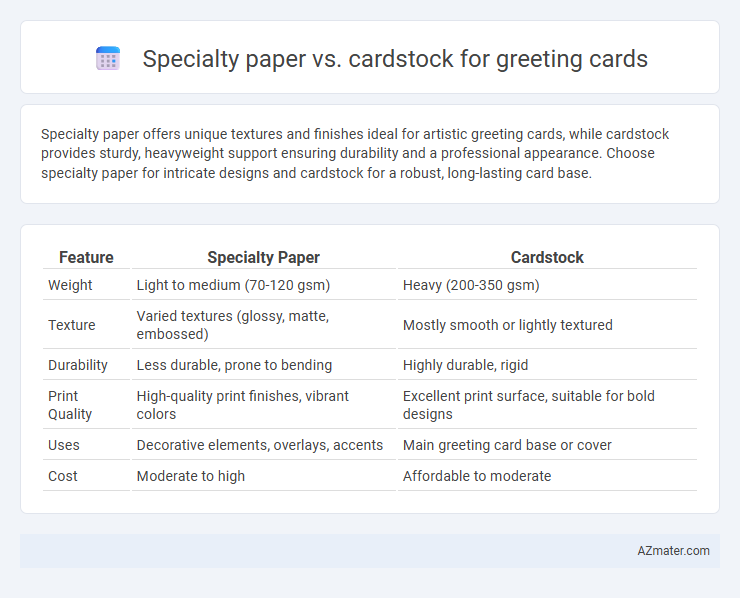Specialty paper offers unique textures and finishes ideal for artistic greeting cards, while cardstock provides sturdy, heavyweight support ensuring durability and a professional appearance. Choose specialty paper for intricate designs and cardstock for a robust, long-lasting card base.
Table of Comparison
| Feature | Specialty Paper | Cardstock |
|---|---|---|
| Weight | Light to medium (70-120 gsm) | Heavy (200-350 gsm) |
| Texture | Varied textures (glossy, matte, embossed) | Mostly smooth or lightly textured |
| Durability | Less durable, prone to bending | Highly durable, rigid |
| Print Quality | High-quality print finishes, vibrant colors | Excellent print surface, suitable for bold designs |
| Uses | Decorative elements, overlays, accents | Main greeting card base or cover |
| Cost | Moderate to high | Affordable to moderate |
Understanding Specialty Paper and Cardstock
Specialty paper and cardstock differ primarily in thickness, texture, and intended use, impacting the quality of greeting cards. Specialty paper often includes unique finishes, patterns, or coatings that enhance visual appeal and tactile experience, while cardstock provides a sturdier, heavier base essential for durability and structure. Choosing between specialty paper and cardstock depends on whether the priority is aesthetic elegance or robust support for the greeting card design.
Key Differences Between Specialty Paper and Cardstock
Specialty paper offers unique textures, finishes, and colors tailored for artistic or decorative purposes, while cardstock is a thicker, more durable paper primarily used for structure and support in greeting cards. Specialty paper varies widely in composition, including options like vellum, metallic, or handmade sheets, whereas cardstock is typically uniform in weight, measured in points or pounds, providing a sturdy base. The key difference lies in specialty paper's decorative appeal versus cardstock's strength and rigidity, influencing the card's aesthetic and functional qualities.
Appearance and Finish: Which Looks Better?
Specialty paper offers a wide range of textures and finishes, such as embossed, metallic, or pearlized, enhancing the visual appeal and tactile experience of greeting cards. Cardstock, known for its sturdy and smooth surface, provides a clean, professional look with high-quality print clarity that holds vibrant colors well. For a premium and visually striking appearance, specialty paper stands out, while cardstock delivers classic, crisp finishes ideal for traditional greeting card designs.
Durability and Longevity Comparison
Specialty paper offers moderate durability suitable for intricate designs but is prone to bending and wear over time, making it less ideal for long-term greeting card keepsakes. Cardstock provides superior thickness and rigidity, ensuring enhanced longevity and resistance to creasing or tearing, which preserves the card's appearance for years. Choosing cardstock improves the greeting card's structural integrity, maintaining its visual appeal and durability against handling and environmental factors.
Print Quality and Compatibility
Specialty paper offers a smooth, high-quality surface that enhances fine details and vibrant colors, making it ideal for intricate greeting card designs with professional print results. Cardstock, while thicker and more durable, sometimes presents slight texture variations that can affect ink absorption and print sharpness, but it is widely compatible with most printers, including inkjet and laser. For optimal print quality, specialty paper supports advanced printing techniques like embossing and foil stamping better, whereas cardstock excels in sturdiness and handling for mailed or handled cards.
Design Flexibility for Creative Greeting Cards
Specialty paper offers a wide range of textures, finishes, and thicknesses that enhance design flexibility for creative greeting cards, allowing intricate embossing, foil stamping, and vibrant color reproduction. Cardstock provides a sturdy base with consistent thickness, making it ideal for structural elements like pop-ups and layered designs while supporting various printing techniques. Combining specialty paper with cardstock maximizes tactile appeal and durability, enabling unique, high-quality greeting cards that stand out.
Cost Considerations: Specialty Paper vs Cardstock
Specialty paper for greeting cards often entails higher costs due to unique textures, finishes, and limited availability compared to standard cardstock. Cardstock typically provides a more budget-friendly option with reliable durability and thickness suitable for mass production. Weighing the cost against the desired aesthetic and tactile experience is essential for selecting the appropriate material for greeting card projects.
Eco-Friendliness and Sustainability
Specialty paper and cardstock differ significantly in eco-friendliness and sustainability, with specialty paper often made from recycled or sustainably sourced fibers, reducing environmental impact. Cardstock tends to be thicker and less biodegradable but can still be eco-friendly if certified by organizations like FSC or made from post-consumer recycled content. Choosing specialty paper supports lower carbon footprints and promotes sustainable practices in greeting card production.
Best Uses for Specialty Paper in Greeting Cards
Specialty paper enhances greeting cards with unique textures, finishes, and colors, making it ideal for creating eye-catching designs and tactile experiences. Best uses include embossed patterns, metallic sheens, or handmade papers that add a personalized, artisanal touch to invitations, holiday cards, and special occasion greetings. Its superior weight and durability also make specialty paper perfect for layered embellishments and intricate die cuts, elevating the overall aesthetic appeal.
Choosing the Right Material for Your Greeting Card Project
Choosing the right material for your greeting card project depends on the desired texture and durability; specialty paper offers unique finishes like metallic, embossed, or handmade textures that enhance aesthetic appeal, while cardstock provides superior sturdiness and weight, making it ideal for cards that need to withstand handling and mailing. Consider gsm (grams per square meter), where specialty papers often range between 120-200 gsm, delivering elegant flair, and cardstock typically spans 200-350 gsm, ensuring robustness. Matching paper thickness and finish to your printing method, such as digital or letterpress, ensures optimal ink absorption and professional-quality results.

Infographic: Specialty paper vs Cardstock for Greeting card
 azmater.com
azmater.com